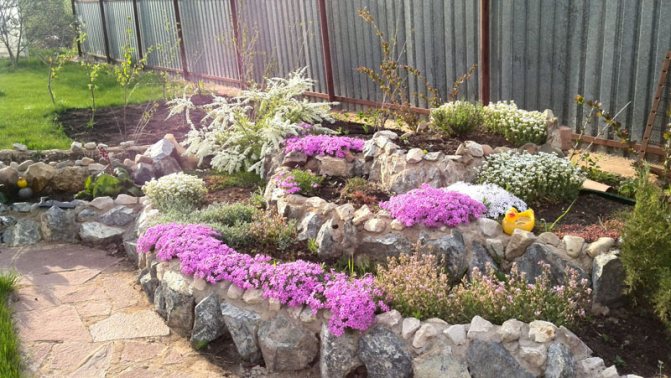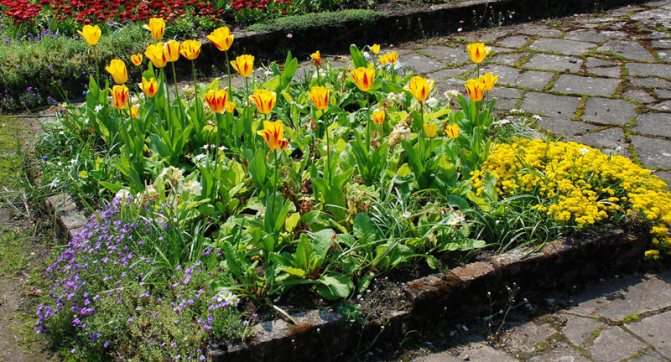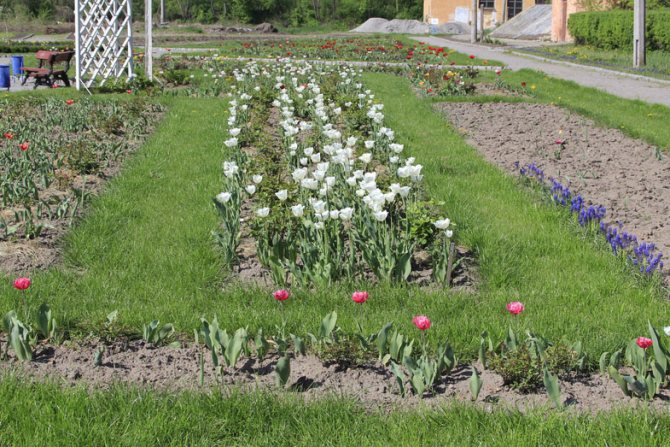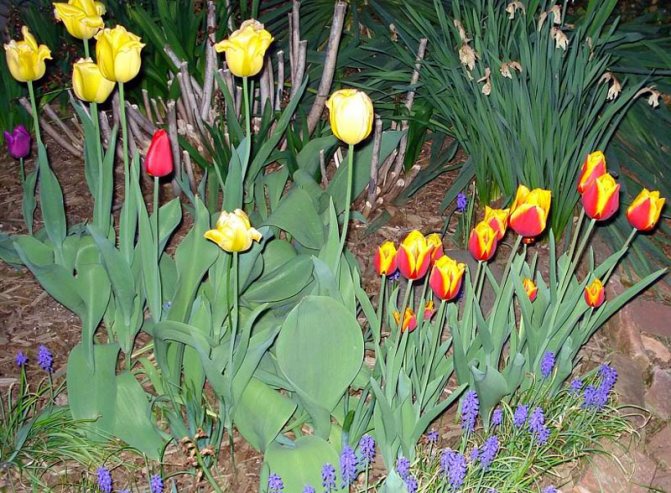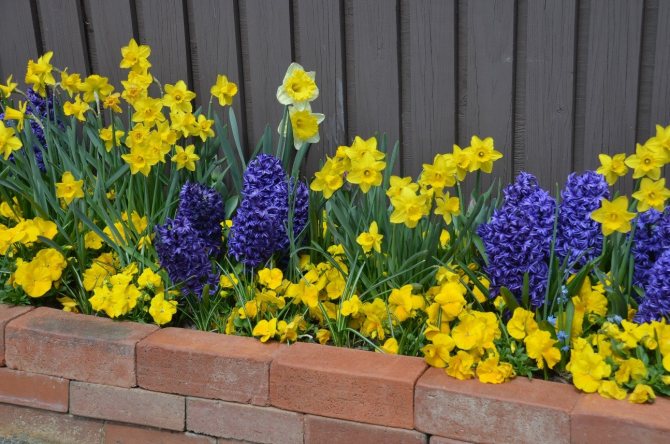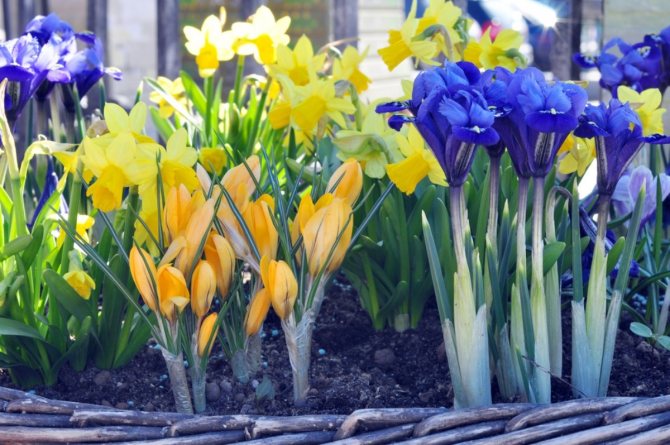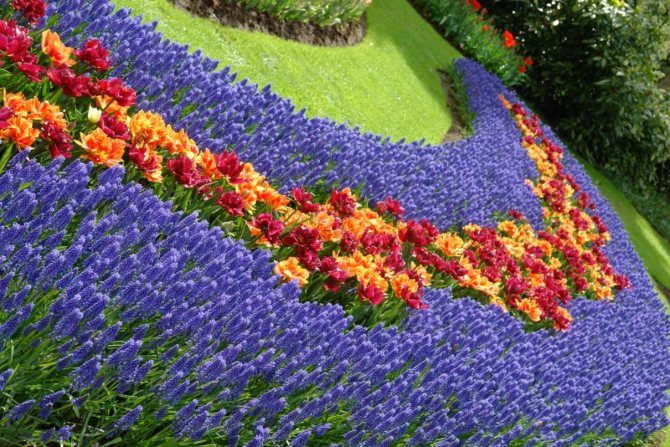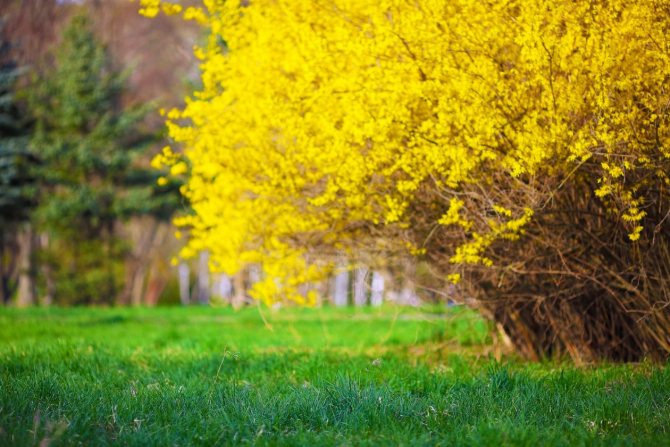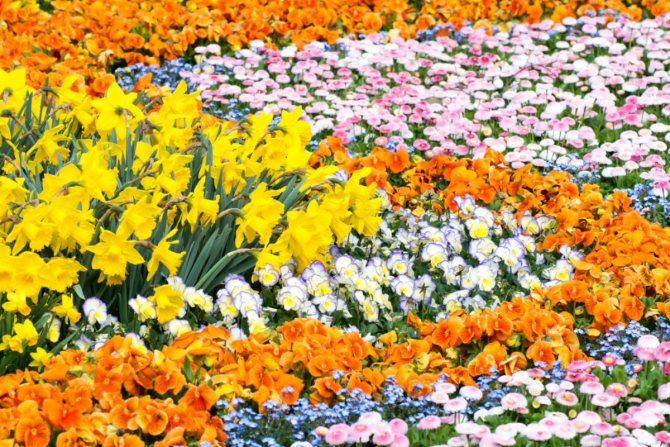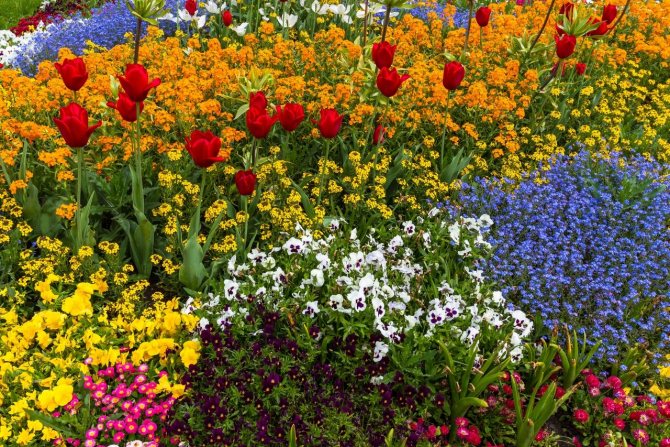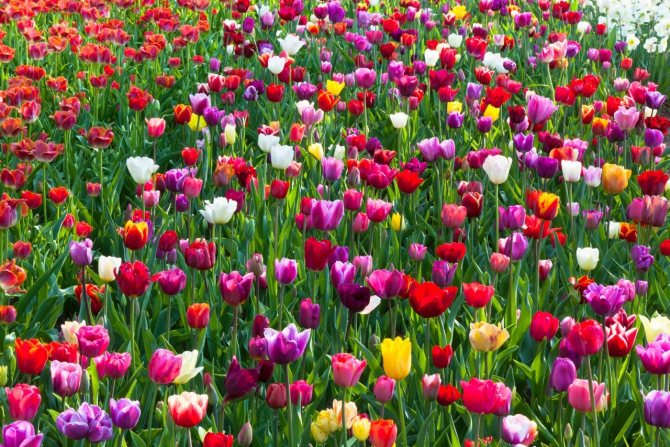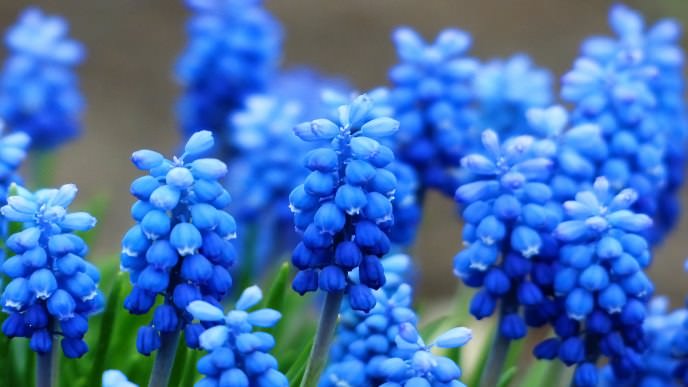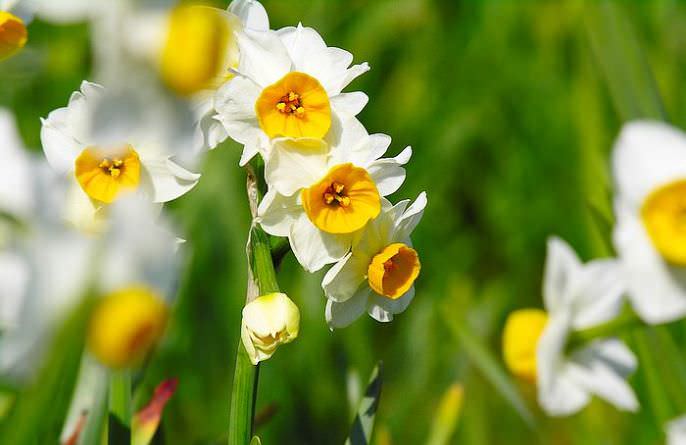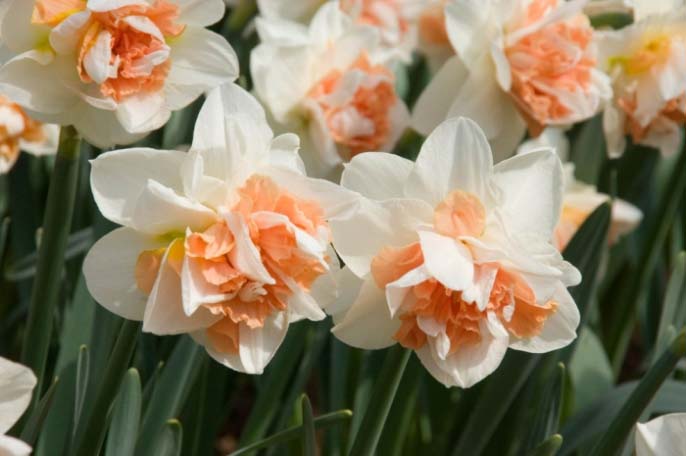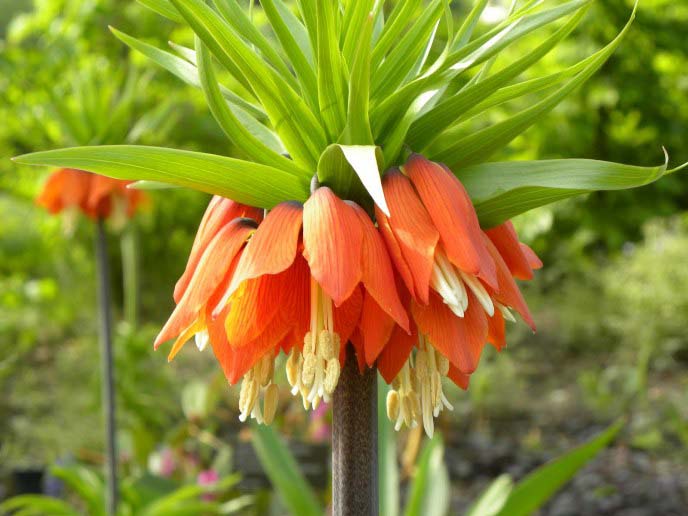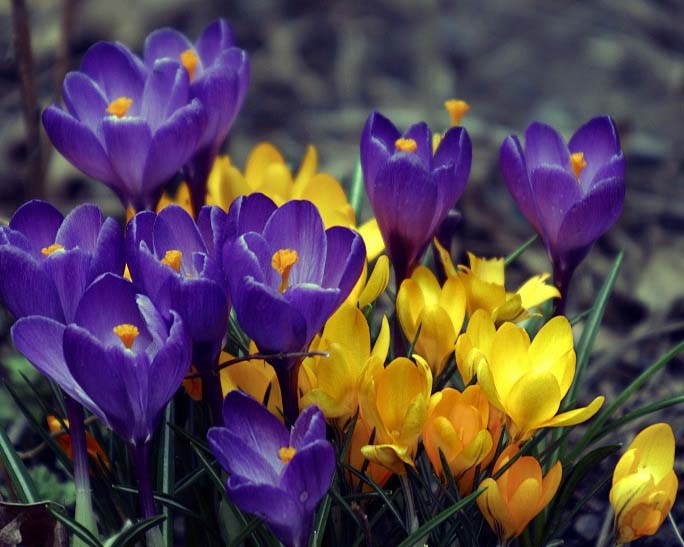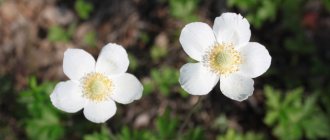
Early bulbous flowers such as tulips, daffodils, crocuses and other cultures are best suited to create a spring "vernissage" in the landscape design of a backyard and to decorate the interior of the premises in the house. The bright palette of colors of these plants, spring greenery miraculously transforms both large territories and small ones, creates comfort and coziness in the house.
On this page, we will share our best practices on how to beautifully plant tulips on the site, show photos and recommend patterns for decorating oriental carpets from flowers. Tulips play the main role in them, they are the center of any compositions. Other plants, flowers and structures should only complement stylish design solutions and not compete with tulips.
The best tulip varieties for growing in the garden
Before planting tulips, choose the right varieties according to their height, external shape and flowering time. In most species, flowering occurs in late spring and lasts up to 25 days.
In landscape design, about 300 different types of tulips are used, the flowers of which are incredibly diverse in the shape of the buds: rounded, bell-shaped, narrowed, peony, star-shaped, fringed, double and lily-colored. All varieties can be divided into 4 groups according to their decorative characteristics:
1. Early flowering (late April). Varieties - Christmas Marvel, Purple Prince, Abba. Looks great in the foreground in flower beds and around curbs.
2. Medium flowering (early May). Varieties - Triumph, Golden Apeldoorn, Pink Impression, Judith Leyster, Happy Generation. They are massively used to decorate flower beds with tulips in city gardens and parks.
3. Late flowering (late May). Varieties - West Point, Marilyn, Menton, Queen Of Night, Uncle Tom, Blue Diamond, Carrousel, Lambada, Texas Flame, Texas Gold, Green Wave. Widely used in any planting style.
4. Species and wild-growing. Varieties - Calypso, Tarafa, Turkestan tulip. Looks great on alpine slides and rockeries. Usually they are used in the Art Nouveau style, a rather non-standard approach to landscaping the site.


What to plant next to chrysanthemums
Light-loving chrysanthemums are one of the most "capricious" neighbors and will get along well on the site with most ornamental crops.
So, they are perfectly set off by sage, coleus, stonecrops, ivy, garden grasses - against their background, the flowering of chrysanthemums will seem even brighter.
If you take flowering plants, then you can add both annuals and perennials to chrysanthemums in a multi-tiered flower bed: dicentra, daisies, monarda, asters, marigolds, dahlias, snapdragons, delphinium, rudbeckia, vernonia, calendula, zinnias.
Of course, monoclombs with multi-colored multi-varietal chrysanthemums will look great - since this plant has plenty of shapes and shades, there is plenty to choose from.
Landing types
Garden design involves the use of a large number of tulip planting techniques and schemes. Most often, there is a planting of one species, a combination of different varieties of tulips and a combination of tulips with other flowering plants. Planting in groups, according to the height and timing of flowering, is also widespread. Let's take a closer look at how to beautifully plant tulips, based on the second criterion.
Group disembarkation
If you are eager to plant tulips in your country house, be prepared to buy several dozen bulbs. These graceful flowers look beautiful only in group plantings. If the tulip bulbs are planted one by one, then the flower bed will turn into chaos.Flowers planted here and there in the garden run the risk of going unnoticed, no matter how magnificent the variety is.
Circular “color spots” of red, yellow and white tulips look very impressive. The key to success is the color transition - you can create a contrasting composition or use a smooth transition. A monochromatic monochrome flowerbed of tulips of different varieties also looks interesting. Experienced florists recommend combining the following types:
- rounded and terry;
- peony and narrowed;
- lily-colored and fringed.
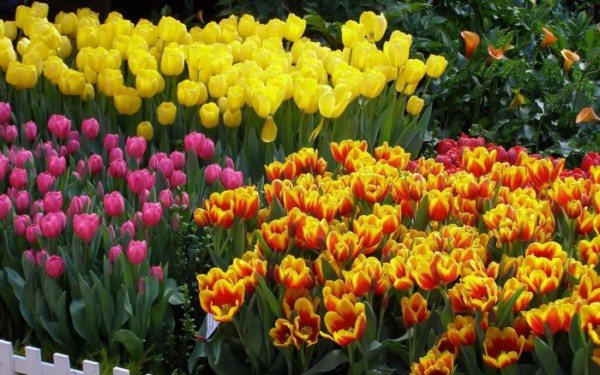

Bulbous flowers should be planted tightly to each other - at a distance of 3-5 cm. There should be 10-20 bulbs in one group, so the effect of density is created during flowering.
Planting tulips in height
This is a very interesting and unusual landing pattern that requires careful attention. When properly planted, the flowers will not shade or overlap.
Tulips should be planted according to their height:
- in the foreground are dwarf and undersized varieties;
- in the middle - the middle option;
- in the background - varieties with large peduncles.
The height will vary from 30 to 60 cm. Such a distribution of colors is possible only on a flat ground. If tulips are planted on an alpine slide, then there may be one variety, since the height will be automatically adjusted, thanks to the multi-level structure of the rock garden.
Most importantly, when planting in height, the plants should not block each other. Otherwise, it can lead to awkward elevations of one species over another. This will ruin the flower bed.
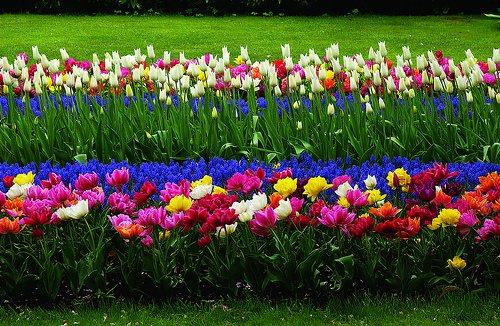

Planting by flowering time
Spring flowers tulips do not bloom for long. To prevent the flower bed from emptying quickly, you can choose the species so that they bloom alternately. The selection of early, medium and late tulips is very large. We described them in more detail just above. So, double and rounded early tulips bloom at the end of April, followed by Darwin's hybrids, Foster's and Greig's tulips, during May, the buds will open tulips of a large group of late flowering.
You just have to decide on the varieties of flowers, and you can turn your garden into a real blooming corner.
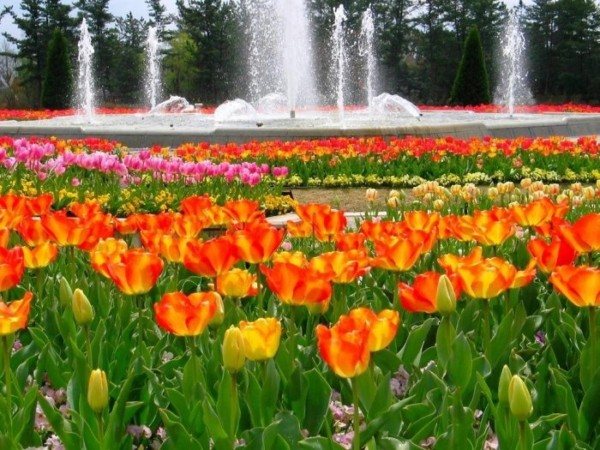

What to plant next to peonies
You will also most often see large sun-loving peony bushes in the garden in solitary plantings due to their significant size and decorative effect. In addition, the peony is a real individualist, demanding on resources, and with a high degree of probability it will shade and survive almost any neighbors, especially if they are carelessly planted at a distance of closer than one meter (this even applies to trees!).
If you have enough space in the flower garden, you can plant any annuals that bloom later, which love the sun and normally tolerate moderate drought, at a distance from the peonies. Against the background of lush green, but already faded peony bushes, they will look like bright accents.
If we consider cultures that are decorative not with flowers, but with leaves, peonies combine well with hosts and a soft cuff.
In longline plantings of experienced flower growers, the peony always goes in the uppermost tier, which either adjoins the vertical surface (fence, wall) behind all the rest of the vegetation, or is the center in circular plantings.
From other combinations, we can recall that the same nasturtiums will become good "medicinal" neighbors for peonies, and lilies of the valley will become a depressing factor.
Interesting design solutions
Recently, many interesting creative ideas have appeared on how to plant tulips in an unusual and beautiful way. Let's write out a few:
1. Planting under trees. Better to give preference to fruit trees. Choose tulip varieties of the same height and matching shades. Kaufman hybrids are ideal.The bulbs should be planted in several rows or in small groups in the near-stem circle. You will get a kind of hedge.


2. Compositions in pots. Portable containers with tulips will be a great addition to any design. Any varieties are suitable for such cultivation. Planting in pots helps to quickly solve the problem with landscaping the site. Plus, they can be replaced as soon as the plants have faded.
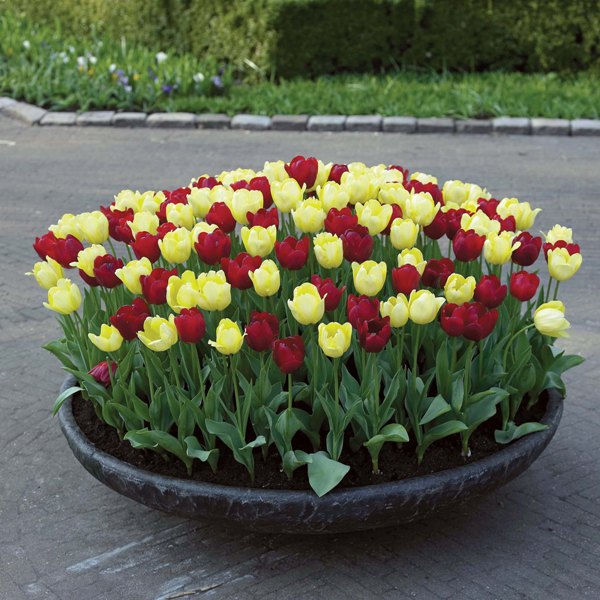

3. Combination of tulips with other bulbous flowers. In this case, you need to choose the right "neighbors". Hyacinths, forget-me-nots, daisies, pansies, primrose and muscari go well with tulips. It also looks good with shrubs such as host, ferns, forsythia, weigela and rhododendron.


What to plant next to irises
Iris is a shade-tolerant culture, decorative, high enough, begins to bloom closer to summer. Based primarily on these prerequisites and neighbors, we will choose it, especially since the iris neighbor is very livable.
Since irises will look great both with annuals and perennials, and even with ornamental shrubs, the whole question when creating compositions with irises will only concern your aesthetic preferences - do you like monochrome and minimalism, or prefer cheerful and rich color compositions.
Read also Pig diseases symptoms and treatment photos
So, according to the contrast of color and size, irises can be paired with lilies, badan or poppies. Ornamental cereals can be added to them in a monochrome flower bed. A flowerbed of irises of one or more varieties of various colors will look great. It goes well with irises lavender, phlox, delphinium, clematis, daffodils, tulips, sedum, heather, lupine, rogersia, nasturtium, petunia ...
Tall varieties of irises usually appear vertically and in the background in a mixborder, while miniature ones can be placed both in curbs and on rocky slides.
Perhaps, only the neighborhood of irises with roses will be unsuccessful - at least, they "overlap" each other visually and will not fully enjoy the view of any of the cultures.
Features of planting tulips
When choosing a place where the flower bed will be located, you need to take into account 2 important factors:
- Lighting. A tulip needs a sunny area that is protected from drafts. On slopes and in the shade, they bloom poorly. They are also badly affected by strong winds.
- Priming. Flowers grow well on light fertile soil (loam or sandy soil).
Planting time is autumn, September-October is well suited. Before planting, the ground should be dug up, all plant debris should be removed, fertilized with humus and the beds should be prepared. The distance between the bulbs should be about 3-5 cm, it all depends on the variety. Planting depth is approximately 3 bulb diameters. The distance between the rows is no more than 25 cm.
If you decide to plant tulips by height, then place the lower varieties on the south side. Otherwise, they will be in the shade of tall brothers and bloom worse.
Recently, many people prefer to plant tulips in containers. This greatly simplifies maintenance and protects the bulbs from damage. Faded plants can be easily removed for ripening in another place. Any container is suitable - plastic and wooden boxes, plastic bottles, special pallets.
When flowering stops, the bulbs should be dug up. They can be planted next year. Tulips from city flower beds are usually dug up when they have green leaves. Gardeners in private plots prefer to dig out when the leaves turn yellow. After that, the bulbs are sent for growing.
Tulips can beautify any site. They can be planted in a flower bed, near paths, trees, and even in special containers. When planning your garden design, be sure to choose the right tulip varieties.
Read also How to speed up the roasting of manure
Early bulbous flowers such as tulips, daffodils, crocuses and other crops are best suited to create a spring "vernissage" in the landscape design of a backyard area and to decorate the interior of premises in a house. The bright palette of colors of these plants, spring greenery miraculously transforms both large territories and small ones, creates comfort and coziness in the house.
On this page, we will share our best practices on how to beautifully plant tulips on the site, show photos and recommend patterns for decorating oriental carpets from flowers. Tulips play the main role in them, they are the center of any compositions. Other plants, flowers and structures should only complement stylish design solutions and not compete with tulips.
How to plant tulips correctly so that flower beds are always beautiful
If you already grow tulips in your garden or under your balcony, then you probably know about the problem of dry leaves. The agrotechnics of growing bulbs provides that it is necessary to dig them out of the ground after the leaves have completely wilted and dried. It is not recommended to dig up tulips immediately after flowering - the bulbs still need time to ripen in the ground. It turns out that after a violent flowering, the garden bed looks not very neat for a month, because tulip leaves dry on it.
- So that dry leaves do not spoil the picture of the whole garden, plant tulips and all other bulbs in special plastic basket containers. They come in different shapes and sizes, and the choice depends on where and in what order you want to plant your tulips.
- After the tulips planted in containers have faded, you can very carefully, without damaging the clod of earth, dig out containers with bulbs and bury them in a secluded place where fading leaves will not spoil the picture of the site.
- A transplant along with a lump will absolutely not harm the bulbs and they will ripen calmly.
- Bulb containers are not expensive at all, but you can build them yourself from large plastic bottles. For examples of using bottles for planting tulips, see the video posted at the very end of this article.
- Before planting tulips, draw a diagram of their placement on a piece of paper. Do not forget to also calculate the number of bulbs you will need for a particular composition.
Creation of landscape design
How the flower beds will look like in the spring, after the bulbs wake up, need to be thought out in the fall. Care should be taken to install wrought-iron and wicker fences, masonry, paved paths, fountains and other attributes in order to create not only flower beds, but also mixborders, rabatki, alpine slides, rocky gardens.


If novice gardeners do not yet have a collection of bulbs from other crops for developing planting schemes, and they do not know what to plant tulips with in a flower bed, we recommend that you consider creating Moorish lawns where bulbous crops can be combined with cereals with wide leaves. You can create separate groups of bulbous, placed in the near-trunk circles of trees and large bushes. In public gardens and parks, landscape designers plant entire tracts and arrange huge "festivals" of tulips, presenting all their splendor and diversity.
Let's take a closer look at how to distribute tulips in the garden, create a landscape design using some schemes.
Rows of tulips
Bulbous plants are planted in a row if the garden plot is divided into zones where individual compositions and elements are repeated, that is, a regular and landscape garden is created and formed. Each section (zone) must have the correct geometric shape. On each of the square mini-flower beds, a culture of the same variety and color, the same flower shape and texture is planted. Then the composition will consist of different bright areas.It is fashionable to alternate tulips in a rectangular flower bed with other plants blooming in the same period of time, for example, with daffodils, creating a border.
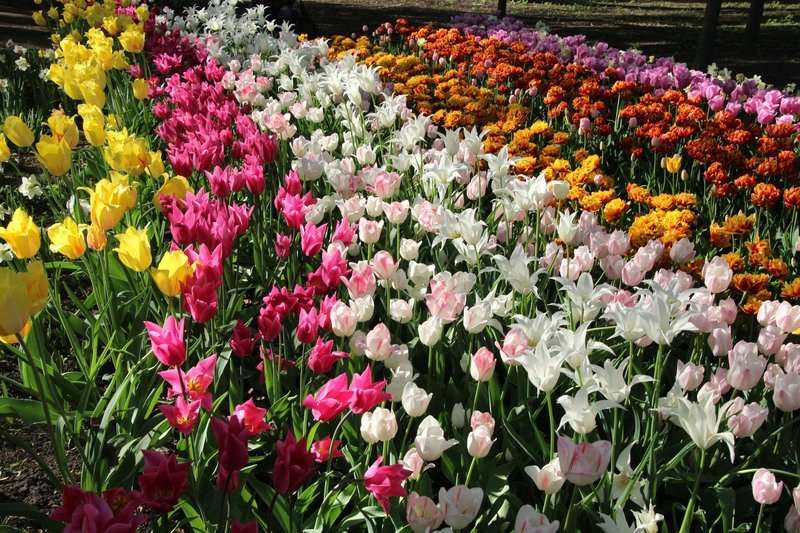

Curb landings
Bulbous planting is most common. Here, the combination of tulips with other flowers on the flowerbed (border) is important, because after the flowering of the bulbous flower is completed, the flowerbed will lose its spectacular appearance, especially with the lower withering and drying plant leaves. They are left so that the bulbs gain strength and develop, and after transplanting in the fall for the next season in the spring, they gave new healthy buds and greens.


Annual or perennial crops are planted that bloom after tulips. The dug out bulbs are replaced with annual seedlings, while perennial flowers will cover the drying leaves of tulips and "save" the beauty and contours of the borders.
Planting in groups
Group plantings always look more spectacular if the tulips are of the same color. If you mix different varieties, then the flower bed turns into a vinaigrette. If tulips are scattered one by one throughout the area among other flowers, then they will be invisible even when they are magnificent. Beds with tulips in the country can be made contrasting: one bright color spot should smoothly transition from one tone to another. Monochrome flower beds of one-color tulips acquire an attractive appearance, but the varieties should be different: simple and double, simple and fringed, simple and lily-colored, etc.


Planting plants of the same height
To organize a flower bed of crops of different heights, the background is planted with bulbs with high stems, the middle part with a culture with medium flower stalks, the foreground with dwarf tulips and other low-growing species of flowering bulbous. The flower bed can be multi-level or stepped, where the flowers do not overlap.


Planting according to flowering dates
Planting plants of different varieties and species with different flowering periods prolongs the life of the flower garden. For example, first, you can admire early simple and double tulip varieties, as well as wild tulips, the flowering time of which begins in April. Behind them, in early May, mid-flowering crops will bloom and late ones - from the second half of May.


Decoration of meadows and mini-lake
On the backyard area, you can organize a trickle from the fountain and a lake (pond). Fountains can be in the form of a steady stream, a hemisphere, a tulip, a bell, a ring, or a fish tail. The pond can be round, elliptical, square, heart-shaped and other shapes with grooves for planting flowers. Everything is lined with stones, gravel, and some areas are planted with plants farther or closer to the water, due to their preferences for moisture. Some plants grow directly in the water of the mini-lake, in shallow water or on the shore, in the shade or in the sun. Tulips of the same color are planted in groups.


Important... To preserve the bulbs, you need to plant them away from the jets of the fountain, and equip the fountain and the lake in a separate recreation area - away from trees, shrubs, hedges, playgrounds, buildings and garden furniture. Ponds should be protected from clogging with fallen leaves.
Plants that should not be planted nearby
Tulips can grow without problems with a large number of plant and flower species. Planting vegetable and fruit crops on the beds is often practiced on the plots. This practice is not prohibited, but growers do not recommend planting tomatoes, strawberries and strawberries with flowers. These tulip neighbors will not improve the quality of growth and flowering.
Tulips are not recommended to be planted with dahlias. They are famous for oppressing almost all neighbors. Many growers consider lilies to be a bad neighbor.
Planting buttercups can lead to problems. These plants quickly absorb nutrients and moisture from the soil.All bulbous plants suffer from this.
Adding an article to a new collection
What flowers can be planted next to each other in a flower bed, so that they do not interfere with each other, and please the eye, and fit into the trends of modern landscape design? Surely every novice florist asked such a question, having received enough space at his disposal on the site.
Of course, the first rule of organizing any personal space is to do it in a way that you like it yourself. But nevertheless, there are some nuances of the combination of colors in the flower bed - and they were formed for a reason. Why not learn more about them before you get started? You will definitely learn something interesting and useful from the experience of other flower growers.
The combination of tulips with other plants
What flowers can be planted with tulips:
- Glades can be decorated with small-flowered crocuses, quinodoxes, muscari arrays, dividing the areas according to the same color scheme.
- Broad-leaved perennials can be partners of tulips, therefore bulbous plants are combined with daylilies, phloxes, geraniums, which are able to close empty spaces with dry tulip leaves after flowering.
What to plant next to daffodils and tulips, such as varieties like Black Hero or Holland, to create a spectacular flower garden:
- gray spirea as a background for Beauty tulips;
- gray spirea and steppe almonds.


Tulips of the Anthracite variety look spectacular against the background of a woolly chisel and between daylilies. After thinking over the color solutions, bulbous plants are planted as companions for ornamental shrubs: spring spirea Grefstein, steppe almonds, holly mahonia, Japanese henomilis and Japanese spirea, common lilac. Here you can choose varieties of lilacs by color and build contrasting or monochrome compositions with tulips. The flight of imagination has no limit, so the bulbs are planted in the trunks of early varieties of cherries, apple trees and plums to create a bright extravaganza of flowering trees and bulbous crops.
Important... Plant bulbs up to 15 cm apart.
Flowerbeds with crocuses and tulips, other bulbs are often made round or elliptical in the form of a basket: they are braided with twigs. Or they take large baskets without a bottom and put them in the ground in different parts of the garden. Sometimes onion gardens are created where perennial culinary onions grow interspersed with various bulbous flowers, including tulips. These can be daffodils or hazel grouses.
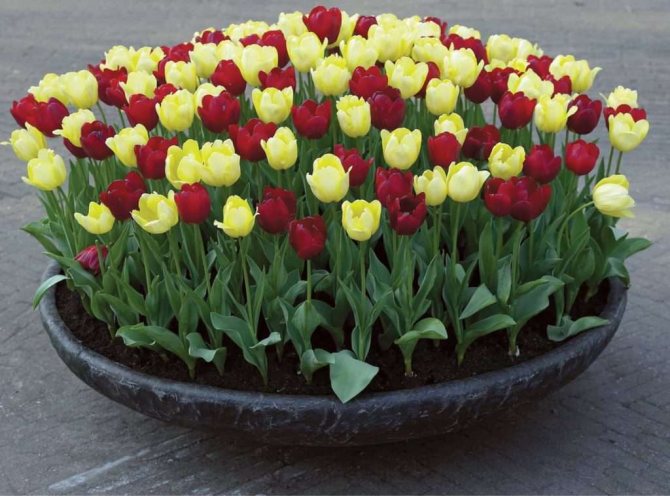

The beauty of the onion design can be enhanced by terracotta or chamotte figurines and ceramic tiles dug into the ground. If a bench with a transparent plastic or thick glass seat is installed in the garden, then undersized varieties of bulbous crops are planted under it and behind it. They decorate buildings: terraces, balconies, patios, entrances to houses or gazebos with flowerpots or pots with tulips.
You can create a composition with ornamental shrubs in the background: rhododendrons, louisiana, weigela and conifers, and in the foreground make a green lawn and distribute bright bouquets of one-color or two-color tulips across it, spaced at least a meter apart. They are planted in pots, baskets, or small squares of land.
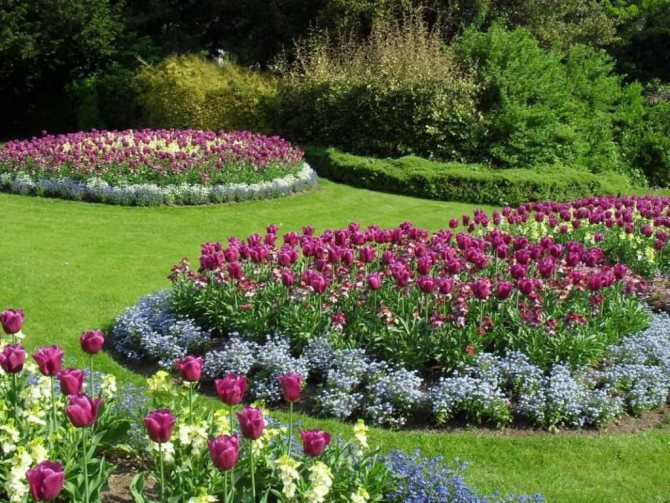

If you plant the bulbs in the center of a compact flower bed, and frost-resistant crocuses around them, then delicate lace will be created along the edge of a romantic composition. Slender hyacinths with an enchanting scent are planted interspersed with tulips, taking into account the tones. In spring, tulips and rainbow irises blooming in April-May will create a festive atmosphere for 2 months.
Read also Design of a small room for a boy
BEST ROSE PROTECTORS AGAINST PESTS
If you plant the following plants next to roses, then you will protect roses from many diseases and pests:
- Yarrow attracts ladybirds, which destroy aphids on rose bushes.
- Marigold control pests and help stimulate the growth of roses.
- Geranium repels most pests of rose bushes.
LOW PLANTS to plant under rose bushes
Since roses, as a rule, grow on rather tall bushes, the following low plants can be planted around them: anise, bells, mint, euphorbia, yarrow, alyssum, larkspur, pansies, flowering tobacco, etc.
Flower garden schemes
A small composition: round, square, oblong or angular with bright colors will attract the eyes in spring, until late autumn. Place it in the partial shade of trees or near the walls of buildings. Non-aggressive flowering and decorative deciduous crops are selected for the neighborhood with bulbous plants. They must be equally demanding on lighting and soil moisture. The root system of partners should be fibrous, loose and underdeveloped, since otherwise it will interfere with the development of vegetative processes in the bulbs. Such a root system occurs in arabis, aubriets, phloxes, forget-me-nots, sedums.


An approximate diagram of an elongated flower bed (number of plants in pieces):
- peonies are planted in the center of the composition - 3;
- to the left of the peonies - tulips - 7;
- further - liatris - 2;
- behind him - cleanings - 3;
- at the left end - host - 3;
- to the right of the peonies - dotted loosestrife - 1;
- further rhizome geranium - 5;
- behind her - Gaillardia - 1;
- further - crocuses - 10;
- at the right end - to the host - 3.
An approximate diagram of a round flower bed:
- in the center of the composition, red tulips are planted in the form of a small circle;
- make a strip of yellow daffodils around the circumference;
- the next strip in a circle made of blue hyacinths;
- behind them is a strip of scrub and mouse hyacinth in purple tones.
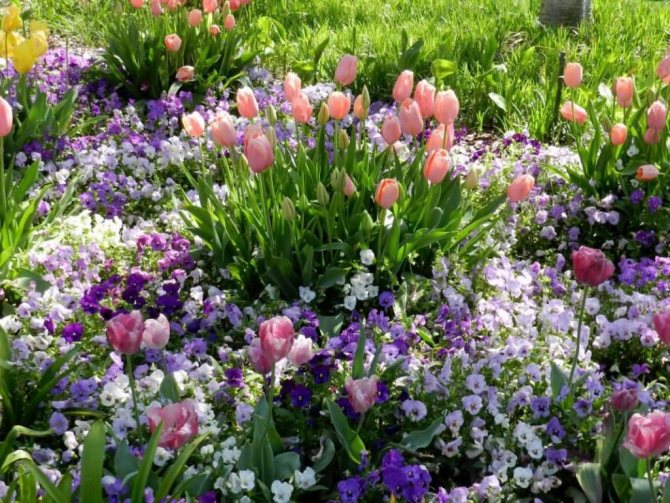

To create a personal composition at your discretion, you can use the following plants:
- thuyu western Smaragt;
- ornamental holly mahonia with evergreen foliage and dark blue fruits, it is planted in partial shade so that it does not burn in the spring sun;
- hosts (at least 3 pieces), make their way at the time of flowering tulips, but after the phase of flowering and drying of tulips, they rise, show their beauty and cover empty spaces;
- tulips with an average flowering period of double varieties and yellow-orange or green colors;
- complete the composition of muscari made from small onions.


If the area for creating a composition is small - about 5m², then 5 varieties of crops are planted, no more. Border is made from undersized bulbous plants. If the flower beds are made up of perennial plants: ferns, peonies, phloxes, hosts, gypsophiles, astilbes, then small islands are left for tulips. When the bulbous flowers wither, the partners will close the dry leaves and prevent the flower bed from losing its spectacular appearance. Also read our article "When to Plant Tulips Outdoors."
The fresh and incredibly cute heads of these flowers let you know that spring is in full swing. They step on the heels of primroses, hurrying to please with bright colors and a cheerful look. To make beautiful tulip flower beds with your own hands on the shoulder of anyone, the process is not complicated and costly. These bulbous plants, which spread from Holland in the 17th century, need a suitable place and careful hands. Knowledge of agrotechnical needs, friendly partners and design solutions will help you.
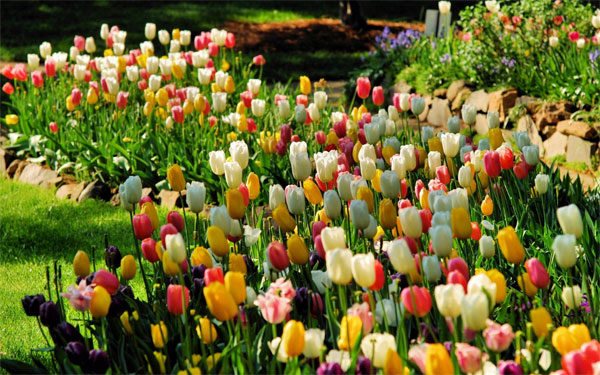

How beautiful to plant tulips so that the flower beds look unusual and original
Large color spots
Flower beds look very beautiful, on which flowers are planted in large groups. Choose tulips of different varieties and colors, and plant them in large groups that close together. Choose tulip varieties of the same flowering time and height.
Below you can see an example of a large group of tulips, made up of plants of the same color range, but of different shapes and colors.
Winding path
It is wonderful and very unusual to see a kind of flower path. Plant tulips in such a flower bed of the same variety and be sure to shade them with flowers of a contrasting color. It is better to plant small flowers such that they will bloom all summer. Then you can plant some other flowers in place of the tulips and the path will delight you all season.
And here is the same path, but made up of only tulips, contrasting in color.
Round flower beds
Standard round flower beds with tulips can look very original if you plant low multi-colored daisies or undersized daisies between tall solid flowers.
And this round flowerbed looks absolutely charming due to the fact that botanical tulips grow on it. The so-called botanical varieties look more robust due to their low height and powerful peduncles. You can dilute the overall compact picture with several tall flowering plants. In this case, it is a common hazel grouse. In color, it can match the color of tulips or be of the opposite shade.
Another example of a round flower bed with tulips, which also serves as a fence for a tree.
Into various containers
Blooming tulips in ceramic home flower pots will decorate the entrance to your home.
Large containers with flowering bulbs look great along garden paths. Place them all over the garden as well.
These tulips in wooden boxes will decorate your garden too, and will look great on your veranda or patio.
And here is an example of using a completely unusual item for planting tulips in it. In this case, it is an old wooden boat. You can use wicker baskets, grandma's iron pots, buckets or barrels in the same way. Be sure to paint old objects or treat them with linseed oil.
We hope that our ideas for beautiful tulip beds will definitely come in handy. And now the promised video about baskets for bulbs.
The fresh and incredibly cute heads of these flowers let you know that spring is in full swing. They step on the heels of primroses, hurrying to please with bright colors and a cheerful look. To make beautiful tulip flower beds with your own hands on the shoulder of anyone, the process is not complicated and costly. These bulbous plants, which spread from Holland in the 17th century, need a suitable place and caring hands. Knowledge of agrotechnical needs, friendly partners and design solutions will help you.
Flower beds with tulips
Choosing a place for a flower bed with tulips
Since the flowers develop from bulbs planted in the fall, the planting site must be selected and prepared in the previous season. Before hibernation, the bulbs grow roots, and in the spring they throw out a stem with a bud. At the end of flowering, the plant is gaining strength for the future life cycle. Most often, it is dug up for the summer and stored until a new planting.
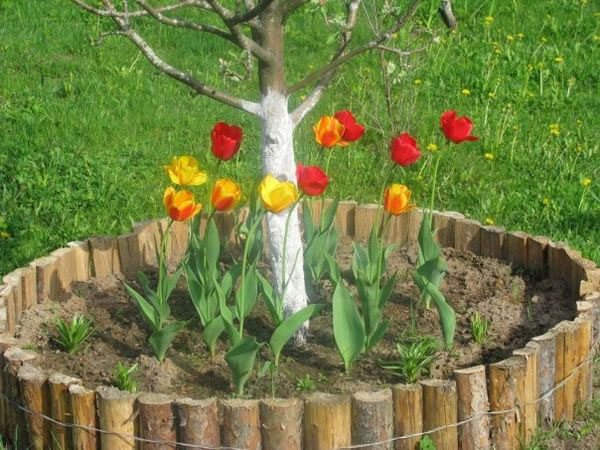

A plot for a flower bed of tulips in the country must meet the following requirements:
- be as even as possible, without stagnation of excess moisture in the recesses, or be on a hill (waterlogging is unacceptable for the bulbs - there is a danger of rotting or freezing);
- be well lit and warm, so that the stems grow even and strong, and the flower petals do not lose color (the north side of the buildings does not fit well);
- have protection from strong gusts of northern winds that can damage flowers and break stems (if drafts cannot be prevented, it is better to plant undersized species).
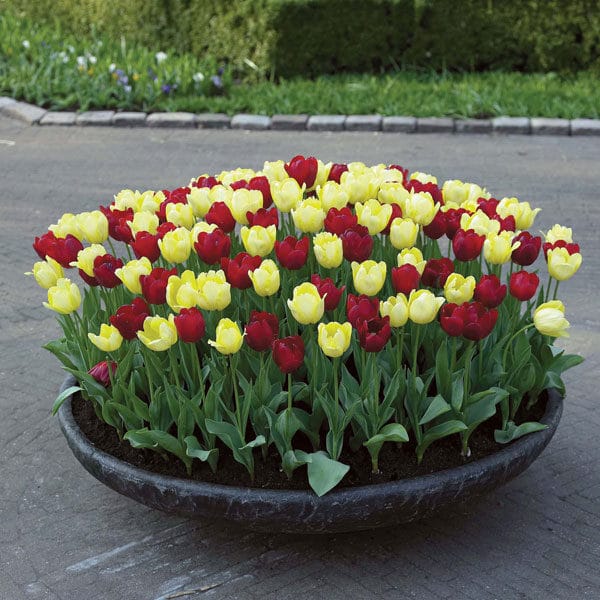

The soil in a tulip flower bed should be fertile, non-acidic, not clayey, with good aeration and drainage.A month or two before planting, the soil is dug to a depth of about 40 cm, cleaned of weeds, disinfected from pathogens and filled with complex mineral fertilizers.
Small flower beds of tulips in the garden can be planted in the area of tree trunks, near shrubs, gazebos or along paths. Variegated blooming groups on the greenery of the lawn or lawn look great and develop.


Beautiful city flower beds with tulips, where plants of the same variety or in various combinations, are planted have not lost their relevance. A blooming corner under the windows of a high-rise building will delight nature lovers. Its best location is closer to the south side of the building. Precipitation flowing from the roof should not flood the site too much.
In order for the flowering of spring beauties to be long and effective, you need to choose varieties that are suitable not only in appearance (height, color and shape of the petals), but also take into account the timing of the appearance of buds. The decisive moment will be the decision on the frequency of digging out the bulbs, the use of compacting or replacement ornamental crops.
VEGETABLES AND HERBS - the best choice
- ONION - the best neighbors for a rose
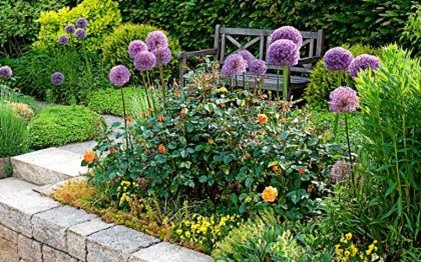

Roses and decorative bow in the garden
All members of the onion family (allium) are useful companions for the rose. They protect rose bushes from aphids and other pests. They also help roses fight most diseases to which they are prone. It is not necessary to plant garlic or leek (although this is ideal), you can opt for decorative bow.
- SPICES - companions of roses in the garden
Like the onion family, many herbs help control rose pests. The best option would be thyme or parsley.
Varietal variety of the king of flower beds
It is widely used in gardening about 300 varieties, they differ in the number of flowers per plant, color, size and shape. The flowers of garden varieties are unusually diverse in the shape of the buds: bell-shaped, rounded, peony-shaped, narrowed, lily, star-shaped.
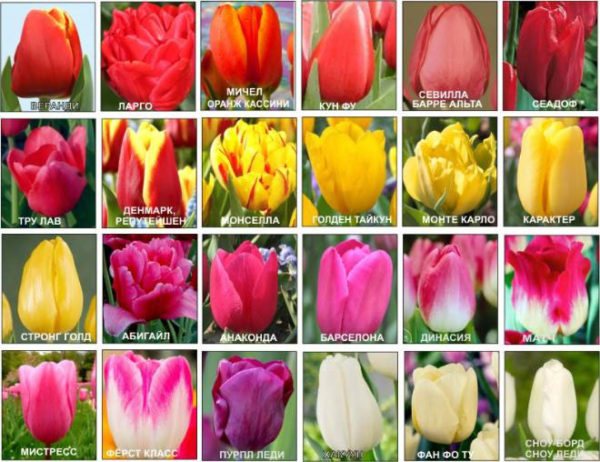

Classification principles and main groups
According to these and other important decorative features, all varieties can be conditionally divided into four groups:
- early flowering (end of April);
- medium flowering (early May);
- late blooming (second half of May);
- wild, species.
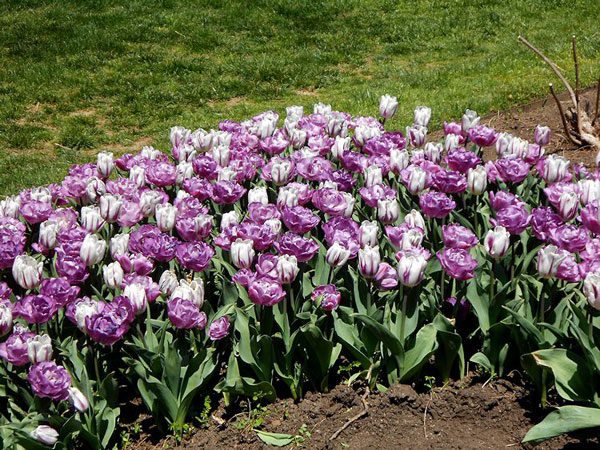

Representatives of the first group, in turn, are divided into two types:
- Simple - Purple Prince, Christmas Marvel. They are characterized by low peduncles, bell-shaped flowers of warm shades (red, yellow). Used for curbs.
- Terry - Abba. Low, very beautiful flower stalks with bright double flowers. Look great in foreground flower beds.
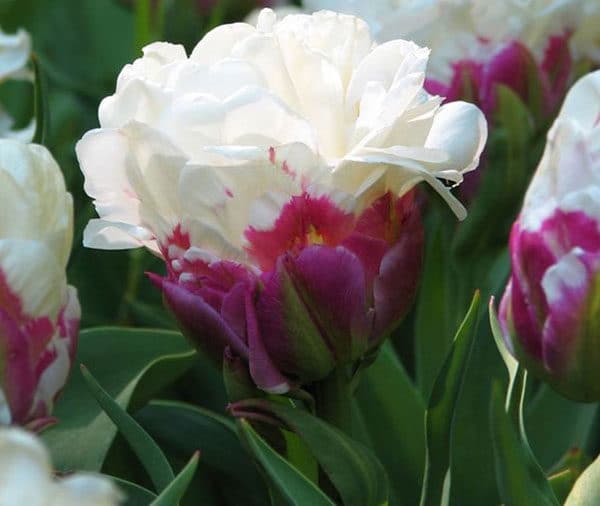

The second group includes:
- All Triumph hybrids have high peduncles, large bell-shaped flowers of various colors (Judith Leyster, Happy Generation). They are massively used to decorate parks, gardens, in city flower beds with tulips.
- Darwin hybrids with very high peduncles (up to 80 cm) and a flower diameter of about 12 cm, mostly red in color (Golden Apeldoorn, Pink Impression).
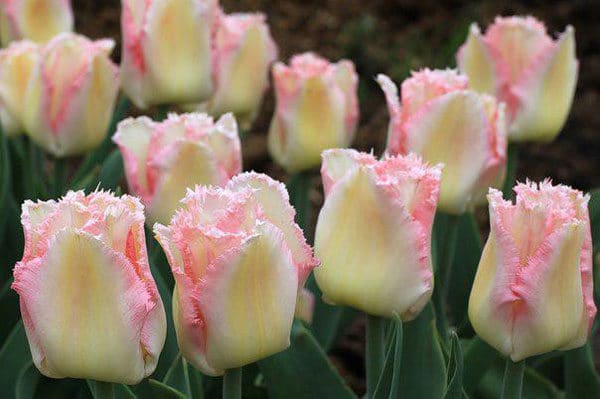

The third group includes:
- Simple (Menton, Queen Of Night) and terry (Uncle Tom, Blue Diamond) - differ from the varieties of the first group in later flowering periods. They are widely used in all types of landings.
- Lily-flowers - flowers have a lily-shaped shape, original for tulips, with gracefully curved sharp petals (West Point, Marilyn).
- Fringed - the petals have a jagged wavy edge, like a fringe. The size and color of the petals varies depending on the variety (Carrousel, Lambada).
- Green-flowered - beautiful varieties that retain their green back throughout the entire flowering, look very unusual (Green Wave). The size of the flowers is up to 7 cm.
- Parrots - got their name from the feather-like, deeply cut petals (Texas Flame, Texas Gold).


The fourth group includes wild species and varieties with a star-shaped flower - Turkestan Tulip, Calypso, Tarafa and others. They are distinguished by their small height, large flowers of an unusual shape and early flowering periods.
The best varieties for different types of flower beds
For landscaping large areas, you should choose bright large-flowered varieties: Purple Prince, Christmas Marvel, Abba, Pink Impression, Menton, Aladdin, Ballerina, Judith Leyster. They will not get lost in the locality and will turn the ordinary landscape into a luxurious blooming corner of nature.
Read also Growing grapes in pots
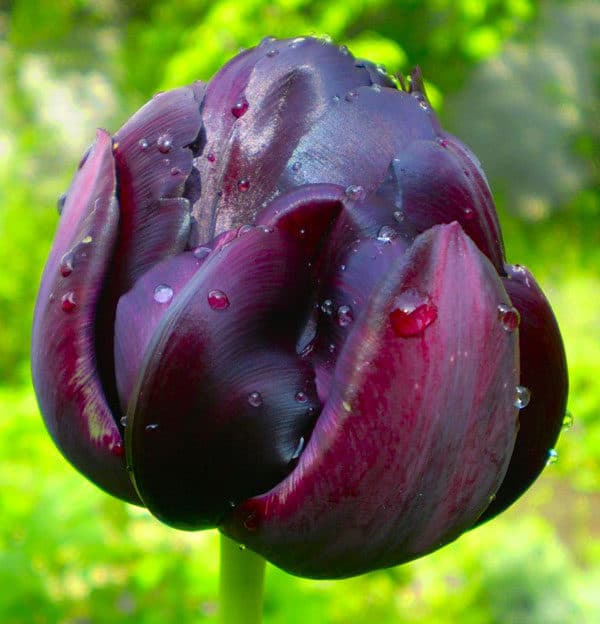

Medium-sized varieties with a classic bud of uniform color, such as Purple Prince, Judith Leyster, Golden Apeldoorn, Pink Impression, Carrousel, Lambada, are planted with hermetic figures in the entrance zones. Variegated elegant early and late double, as well as fringed and parrot varieties, look spectacular in group plantings in the foreground or background of tulip beds in the garden.
Low-growing varieties, for example, Uncle Tom, Tarafa, should be chosen for group plantings near paths; among the green lawns. All varieties of tulips are suitable for mixborders, the main thing is to make the right composition.
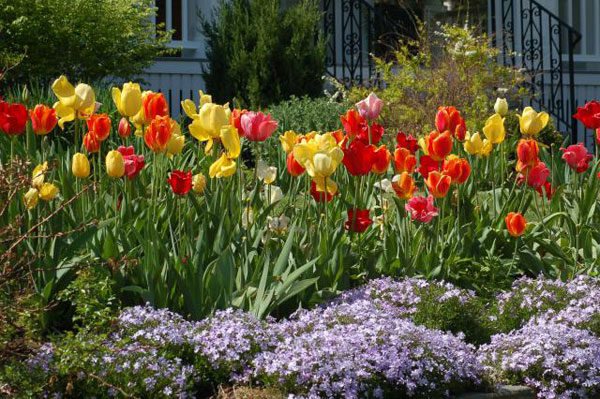

With a non-standard approach to landscaping (creating rocky gardens), wild tulips and their hybrids are widely used. They look great in rockeries and alpine slides and look very original.
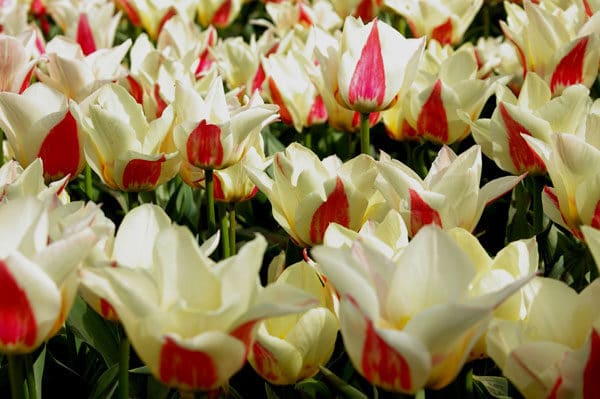

What to plant next to lilies
Like roses with peonies, lilies in the garden feel most comfortable “on their own”. Large, voluminous, noticeable ... In addition, recently, Asian and Oriental hybrids of lilies have become especially popular, in which flowers are formed in large quantities, and the flowering period can last several months. Isn't it a perfect tapeworm?
Usually lilies in a flower garden are planted in a kind of "islets", combining them according to colors or varieties. A wonderful option would also be assorted lilies, planted in one group, but in two or three tiers.
If you absolutely want to combine this tall, regal flower with other plants in your garden, pay attention to low and medium-height perennials - for example, incense or peony.
You can go in an unconventional way and pick up companion plants that are completely unusual at first glance, like Echinacea or Eringium (Eryngium), in a company with the lilies. Of course, it will be important here to "play" with the shades of these colors, so that instead of the expected exotic you do not get a lurid "something". However, this applies to any flower combinations.
Also, lilies will look good in a company with hosts, since even their inflorescences are similar in shape (this is especially true for wavy, tall and swollen hosts). In addition to adding lush greens to your flower garden, hosts can also choose these plants so that they bloom with lilies in turn.
Planting tulips in a flower bed
Before planting tulips in a flower bed with your own hands, you should imagine its future appearance in color and determine the required number of bulbs. The average amount of planting material is 10 units on an area of 0.25x0.25 m (about 100 pieces for a checkerboard pattern are needed per 1 m2).
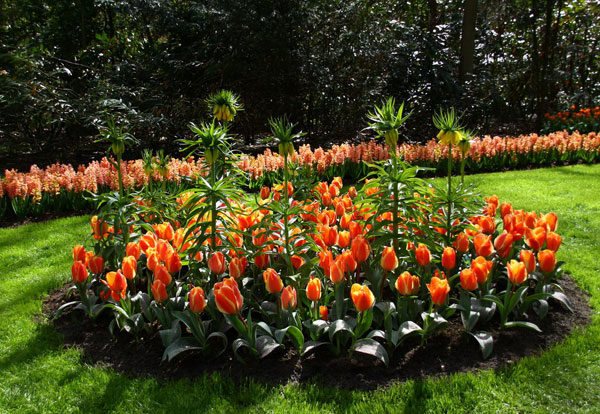

How to plant tulips in a flower bed
Plants should not interfere with each other's development, they are placed with a step of about 10 cm in a row (depth is about three bulb diameters), between rows they stand about 25 cm.With different heights of varieties, low tulips should be placed on a flower bed on the south side so that they do not suffered from the shadow of their taller brethren.
The modern method of planting is in special trays (baskets), which simplifies maintenance, protects the bulbs from damage when digging up and from being eaten by rodents. Faded plants easily move from the site to another place for ripening. For bulbs, other containers are also suitable (bottles, lids and plastic containers, plastic boxes with grates).


Combination schemes and techniques
To successfully break a tulip flower bed, you should read the following recommendations and choose the right ones:
- effective and often used group planting of the same varieties or colors;
- at least five onions are planted so that the flowers are not lost against the background of others, the optimal group is 10-15 pieces;
- different varieties are built according to height (in the center or in the background - the highest, then - medium, in front or along the edge - low);
- combine companies of early and late flowering plants, alternating between them.
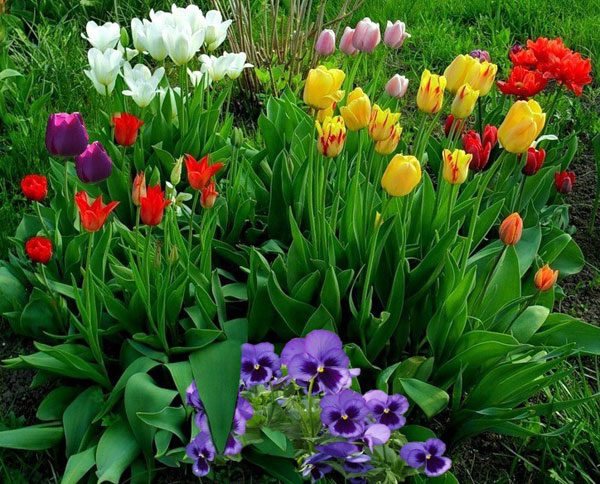

There is a multilayer planting method, when the bulbs that bloom later are placed deeper in the soil, then - with an average flowering period and behind them - early ones.
All kinds of design solutions include the following schemes for planting tulips in flower beds, taking into account the size and shape of the site, personal tastes:
- random placement creates the effect of a natural lawn;
- multicolored varieties are planted inside, and the edges are framed with plain colors;
- create geometric patterns or an ornament from tulips, placing them in a certain order on a flower bed;
- combine plants with related color of buds or with contrasting (warm and cold) tones.
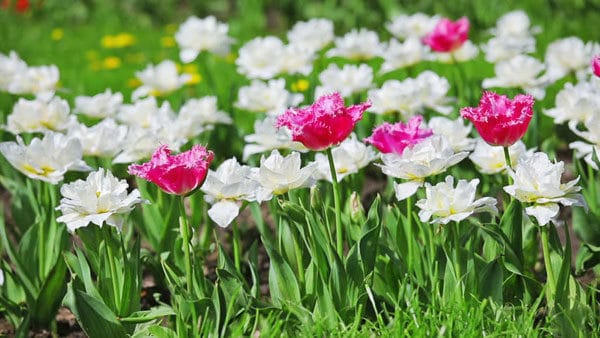

Combination with other plants
The problem of what to plant in a flowerbed with tulips is solved by selecting suitable non-aggressive flowering and decorative deciduous crops that fit into the overall composition. Neighbors can be different plants that have the same requirements for the structure and moisture of the soil, for the degree of illumination.
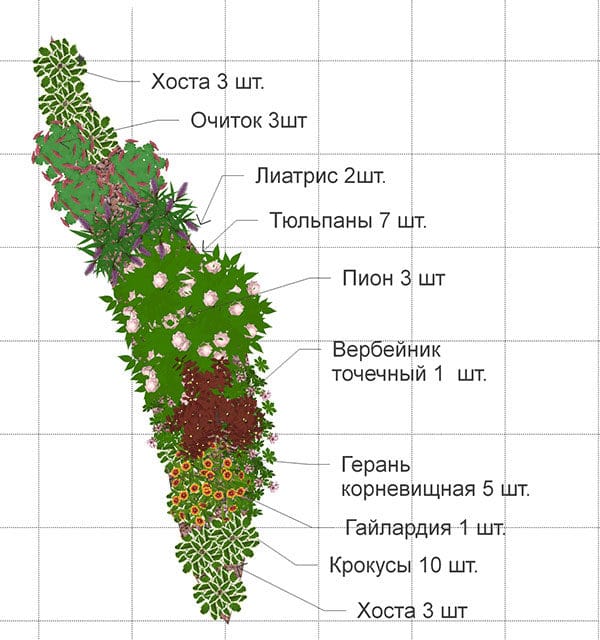

The rhizome system of partners in the flower garden should not be too developed so as not to inhibit the vegetative processes in the bulbs. Annual transplanting is not always practiced and not for all varieties, so permanent combined flower beds can be created.
A different approach is needed for the design of the seasonal (spring) and permanent flower beds. After the flowering period, the tulips can be dug up and used for seedlings or garden plants. Frequent partners on the plots are spring bulbous, it is very convenient that they need the same care.


The planting of annual beautifully flowering crops (variegated petunias, pansies, asters, daisies, zinnias, daffodils) helps to preserve the decorativeness of the flower garden throughout the season, the growing season of which ends by mid-autumn. Then the plot is again freed up for the wintering of the bulbs.
In a permanent flower garden with perennial plants, areas for tulips are left. At the end of the growing season, their wilting unsightly leaves are masked by other crops that have grown by this time. Suitable as neighbors astilbe, gypsophila, peonies, phlox, hosts, ferns.
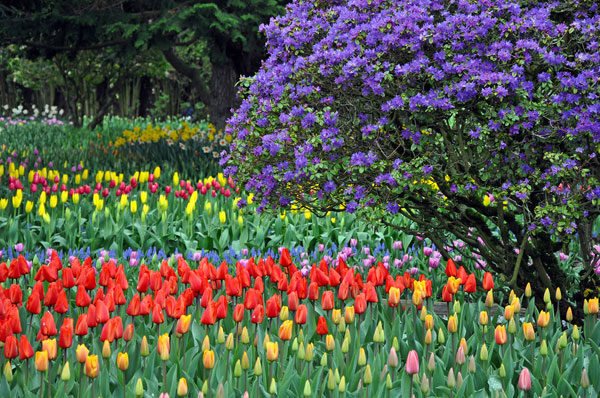

Mixed compositions with decorative shrubs in the background (rhododendron, luiseania, weigela), as well as with conifers, are successful.
On a perennial flowerbed with tulips, it is good to combine decorative crops of ground cover varieties - arabis, obrietu, phlox, forget-me-not, sedum. They have shallow, loose roots and do not interfere with the development of bulbs.


Design solutions for a combined flower garden
In a small area of up to 5 m2, it is reasonable to plant no more than five varieties of ornamental crops, collecting them into a single composition. The border of low-growing plants looks good. You should take into account the seasonal change in the picture of the flower garden and, if possible, correct it.
The placement of tulips with other flowers in a flower bed should be thought out so that their appearance harmoniously combines or sets off the beauty of a neighbor. It is necessary to take into account the parameters of partners so that they do not cover each other and do not cast a lot of shadows.
In flower beds with several tiers, tulips should not be planted from the very edge; it is better to allocate areas for them a little further away so that you can later cover them with other plants.


To decorate a flower bed of early flowering plants with their own hands, tulips and elegant daffodils are often used. Plants create a striking color contrast, highlighting each other's beauty.
A flower bed with tulips and frost-resistant crocuses looks romantic. Crocuses are placed with delicate lace along the edge of the site.
The composition of tulips and slender hyacinths, emitting an enchanting aroma, looks interesting and gentle on the flower bed. They can be planted in a mixture, choosing matching tones.


A classic and win-win option is the neighborhood of tulips and bright blue muscari in the same flower bed. They get along well together, muscari are unpretentious and create a favorable background.
The festive atmosphere is felt in a flower bed with tulips and rainbow irises that bloom from April to May for two months. You should select varieties that match in growth.
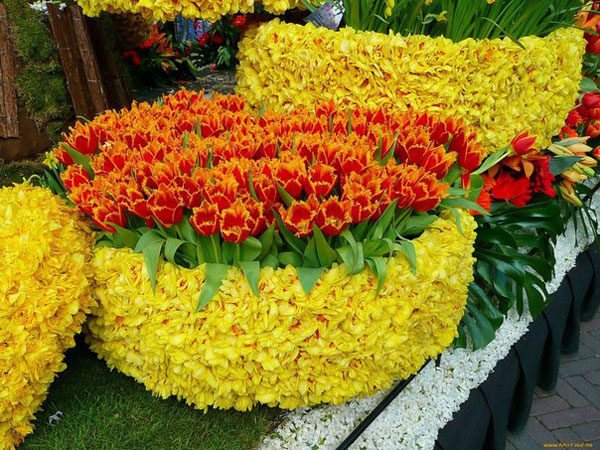

The main principle when placing on a lawn or under tree crowns is a natural appearance. Groups of tulips are planted in several separate groups, trying to choose the most illuminated places.


The unique charm of fresh bright buds makes you create fabulous spring decorations from year to year. The key to the success of a beautiful landscape design with your own hands is high-quality planting material, a successful and prepared place, a favorable neighborhood and competent care.
Beautiful flowers create a sense of celebration in the soul. Perfectly complement the green lawn and shrubs with bright colors. Garden decoration. Further
Every year, new creative ideas appear in the design of the site and fresh trends in landscape design. But they are also familiar for a long time. Further
There are so many flowers in the world, but clearly there are such that we have never seen! ... Further
The owners of suburban areas do not count on the help of landscape designers, but prefer to independently create a creative fabulous garden, which. Further
After a long winter, hands are itching to equip a place for ornamental plants in a suburban area - for yourself. Further
A bright, well-groomed flower garden is a decoration of any summer cottage and personal plot. In the arrangement of landscape design, you can use the available ones. Further
It is not necessary to hire a landscape designer to decorate a personal plot. You can easily make beautiful flower beds of stones your own. Further
What to plant next to roses
Avid rose growers are of the opinion that the queen of flowers is truly self-sufficient and does not require any other flower crops as a frame. Looking at the huge luxurious bushes, hedges, ridges, "walls" and "arches" of roses, it is difficult not to agree with this. There is plenty of volume and color here without other colors.
This splendor looks especially good on a monochrome background - a brick or plastered wall or a manicured green lawn.
However, no one bothers you to experiment and add other plants to the rose garden. So, a flower garden with bright roses will perfectly set off the planting of conifers - remember only that you need to plant them at a distance from each other, because both require a lot of space for growth and development.
If there is enough space between the roses, you can shade them with discreet plants with small dull flowers of calm shades - gypsophila, sage, katran, lavender, heuchera, lobelia. Also, blotches of tall ornamental grains (fescue, evergreen oats, etc.) or, for example, silver wormwood, are perfect for this.
You can make a flower bed where roses will coexist with the same large and bright phloxes, delphiniums or clematis - close shades (burgundy, pink) look especially good, but you can, on the contrary, use contrasting ones.
An interesting solution for breeders of climbing roses will be their combination with climbing grapes. These plants have similar agricultural techniques, for the winter they are covered with the same materials and they are treated in a similar way from pests and diseases - very convenient.
Not far from the rose garden, you can plant protective plants that can drive away insidious pests like aphids, nematodes and others. The ideal option is marigolds, marigolds, lavender, sage, clematis.
But what should not be planted next to roses is carnation, mignonette, peonies, because they all have a depressing effect on the queen of flowers (or vice versa - she is on them).
Flowers and their neighborhood - choosing candidates: photo
1. VELVETS Perfection1 F1. The bush is compact or spreading with a pronounced main shoot and completely round densely double inflorescences up to 15 cm in diameter.The bush is powerful, strong, well branched, 35-40 cm high, 30-35 cm wide.Plants look great in borders, flower beds and beds , go well with phlox, dahlias, asters, geraniums. Flowering from late June - early July until frost.
2. BRAHICOMA is an annual plant 15-25 cm high. The bushes have numerous inflorescences with flowers 3-3.5 cm in diameter. Reed flowers are white, blue, purple or lilac-pink; tubular (smaller) - blue or almost black. Abundant bloom, from mid-June to September or October, depending on the weather.
3. CORN - a biennial or annual herb with a height of 60 to 80 cm. Flowers of garden forms can be white, pink, purple, red. Unpretentious, but loves sunlight, blooms from June to September. Grown in open ground in a sunlit place, the distance between individuals is 20-50 cm.
4. BEARDED DIATION - most often an annual crop up to 30 cm in height, strongly branches, forming a spherical bush. The flowers are small, up to 2 cm in diameter, pink in color, of different shades, often with a yellow spot in the neck. It tolerates a lack of moisture well. therefore, it is quite suitable for planting in containers, it is widely used to decorate the borders of mixborders, the edges of flower beds and garden paths.
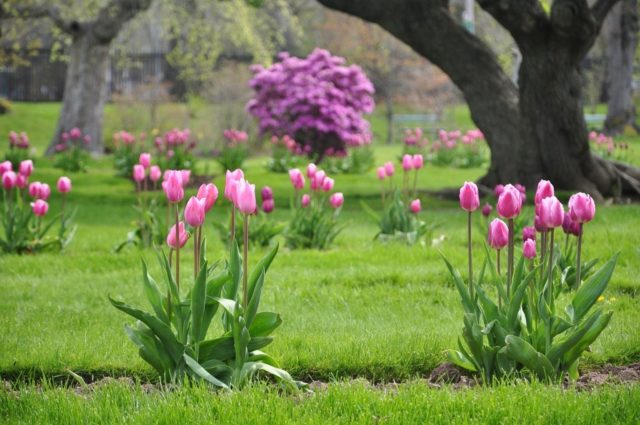

5. NEMESIA ZANOVIDNAYA - an annual plant 30-40 cm high. The flowers are bright orange, yellow, pink, red or variegated, up to 2.5 cm in diameter. This is one of the best annuals for borders or groups in prefabricated flower beds, as well as for planting in flowerpots and balcony boxes. Flowering continues until the end of September. To provoke a second wave of flowering, cut off the faded stems at a height of 15-20 cm from the ground
All bulbous early flowering plants have approximately the same requirements for the place and soil under the flower garden:
- the soil should be fertile, loose, air- and moisture-consuming, neutral acidity. The groundwater level should not rise above 60-75 cm,
- the place for the flower garden should be well lit, but at the same time protected from the sun.
In the shade of trees, a bulbous flower garden is possible if it is early flowering woodlands, hyacinths, tulips, crocuses, galanthuses, daffodils and hellebores, in which the flowering period ends before the larch trees produce dense foliage.
Autumn planting of bulbs (video)
Florists need to remember the following nuances:
- tulips, daffodils, snowdrops and hyacinths form bulbs covered with a thin shell;
- hazel grouses and lilies do not have bulb protection;
- for crocuses and gladioli, the formation of corms covered with scales is characteristic.
You cannot purchase planting material for lilies and crocuses immediately after forcing. Failure to comply with this rule is fraught with depletion of the supply of nutrients. Such plants will not produce flowers for a long time. High-quality and beautiful flowering can only be obtained from healthy and strong planting material for crocuses and other bulbous plants.
It is important to free the bulbs packaged in packages and to reject the heavily damaged or sick ones. It is necessary to plant purchased bulbs on a flower bed after cleaning and processing from infections.After removing the integumentary scales from the apparently healthy planting material, fusarium can sometimes be detected. These mold-like stains will need to be scrubbed and removed with powdered fungicides.


When to plant the bulbs?


Daffodils and hyacinths should be planted in the ground in late summer - early autumn, tulips are planted later - in early October. All bulbs take about a month to form a root system, so place the bulbs in the soil no later than a month before the onset of stable frost.
In the same period, it is necessary to take care of planting ground cover plants, spring and summer flowering perennials and biennials.
But rhizome perennials, such as primroses, are planted in early spring. In this case, you should take into account the following point, in order to achieve the most complete and colorful flowering, you will need more than one year, because perennial plants take time to grow.
What they love and dislike
So, having decided on the bulbs, you can also choose a place to break the flower garden. In this case, it is necessary to take into account the requirements and characteristics of the flower culture.
Since the origin of these flowers is Asian, they also prefer habitats:
- warm, well warmed up;
- solar;
- protected from the winds.
Also, the selected area for the flower bed must be protected from waterlogging. In swampy soil, the bulbs quickly rot.
But the soil for them should be:
- sandy loam;
- wet;
- loose;
- humus-rich;
- slightly alkaline or neutral;
- well drained.
All this must be taken into account when choosing a site for laying out a flower bed. It is better to choose a place where potatoes, legumes or cabbage were previously grown.
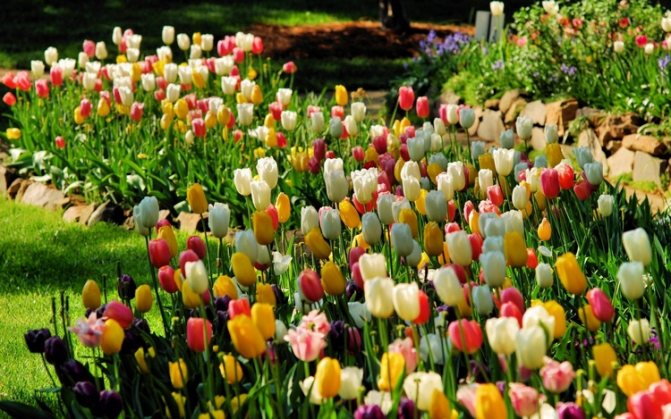

Expert advice
Many flower growers want to create a beautiful landscape design with tulips. However, not everyone succeeds in this, since some do not know the peculiarities of growing tulips. Therefore, it is recommended to study in advance the main ideas and recommendations of specialists that will help grow these flowers:
- Timely pruning of plants. It is necessary to prune after the appearance of the first yellowed leaves. Such yellowness indicates that the tulips lack nutritional components. Therefore, in order for the bulb to quickly accumulate the necessary substances, it is necessary to do pruning.
- Handle the leaflets with care. Inexperienced growers carelessly care for tulips, which can damage the leaves. Experts advise not to touch them until they begin to turn yellow, so as not to disrupt the supply of nutrients to the bulb.
- Regular addition of dressings. It's no secret that tulips, like other flowers, need feeding. Therefore, when growing flowers, it is necessary to periodically add potash and nitrogen fertilizers to the soil, which contribute to the development of tulips. Organic matter is added once - during planting in the ground.


How to form plant groups
The most acceptable would be to create a composition consisting of various types of perennials and bulbs (15-25 pieces each).
In the foreground, flower beds are usually planted with low-growing small-bulbous ones, interspersed with hyacinths. Behind them are tulips and daffodils, which perfectly complement early flowering perennials. For example, sunny yellow daffodils will effectively coexist with a sky-blue brunner, and a lilac decorative bow will set off a golden doronicum.
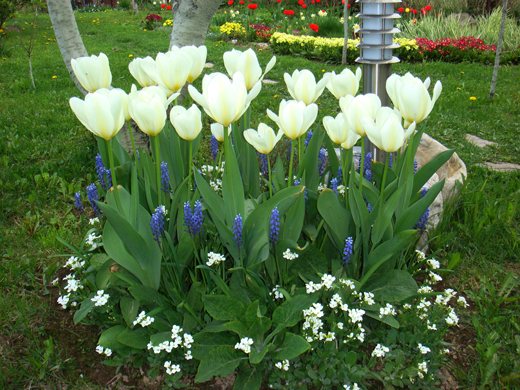

Bulbous plants are often combined with perennials that bloom in summer. Moreover, in this pair, bulbous act as a background, and perennials compact the composition. For example, for forget-me-nots, primroses, violas and daisies, red tulips are an excellent setting.
Your flower garden will be even brighter and more spectacular if you plant daffodils in the form of a wavy ribbon, and hazel grouse and crocuses in groups in the form of spots.
Late-flowering bulbs (hyacinths, tulips, bluebirds, crocuses) perfectly coexist with roses, which bloom in our country from mid-June. Later, the place of bulbous plants is taken by undersized annuals.
It's important to know! After the bulbous plant has faded, their peduncles should be cut off, but the rest of the ground part is left until it completely turns yellow. This is done so that the bulb remaining in the ground can complete the growing season and form the embryos of plant organs for the next season.
Most often, perennial flowering plants, including bulbs, are planted in groups. The size, number of crops and planting height are determined by the size of the flower garden, as well as the types of shrubs and trees that surround it.
To ensure that the lawn does not lose its decorative qualities throughout the season, it is necessary to provide for the planting of annual and biennial crops instead of those that have already faded. Annuals do not form a large root system, so that layer of soil above the bulbs will be enough for them to produce good flowers.
It's important to know! Plant such annual plants as salvia, cineraria, petunias, zinnias, marigolds with ornaments, having previously marked the pattern on the flower bed.
When forming groups, shrub framing is usually made. Woody groups should be used according to the principle - light deciduous shrubs should set off plants with light flowers, shrubs and trees with dark foliage - crops with bright flowers of saturated color.
Read more: Grape seedlings OKS. Planting and leaving.
Groups of plants of the same type should be placed at a distance that takes into account the size of the growth of specific crops. Otherwise, they will begin to oppress each other. So, for 1 square meter of landing area they take:
- from 1 to 3 pcs of tall plants,
- 5-10 pcs of medium height,
- 20-30 pcs undersized,
- up to 50 dwarf bulbs.
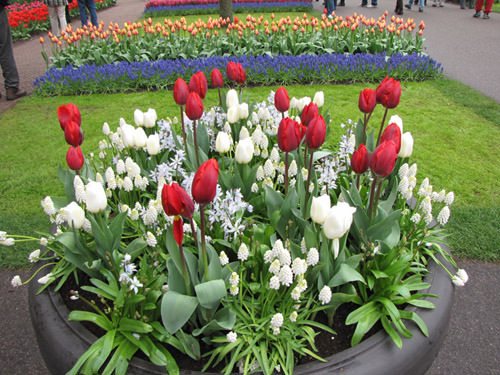

With such a density of plantings, the plants will grow normally, give bright, well-developed flowers.
Perennial flower bed - primroses, daffodils and tulip
Simple groups can include up to 2-3 species of any bulbous, regardless of the timing of their flowering. In this case, tall tulips or daffodils are planted on the back of the lawn, and the undersized or the most beautiful plants should be in the foreground. Thus, all components of the group must be clearly visible.
There are groups that are selected by color and texture. For example, take pink tulips and rich blue forget-me-nots as the main plants, and use low-growing red tulips in combination with white daisies or dark blue crocuses with snow-white daffodils for the border.
A group consisting of irises surrounded by primroses will look very impressive. Moreover, in planting irises, use multi-colored varieties. Primroses can also be planted in different varieties - spots.
When forming a group, take into account the flowering periods of bulbous perennials so that in the flower garden, those plants that have already bloomed are replaced by new ones, in which the flowering period is just beginning. This will give the flower bed a different color combination at any time.


In mixed groups, different types of plants are planted mixed, which bloom at different times.
We hope that these simple tips will help you create a small paradise in your summer cottage, which will delight you with its appearance from early spring to autumn for many years.
In fact, everything is extremely simple! Everything related to planting tulips, crocuses and other spring-flowering bulbous plants in dense groups. After their flowering and wilting, the leaves and former peduncles are cut off and annual flowering plants are planted in this place.Plants such as marigolds, zinnias, petunias, salvias and cineraria are planted with patterns previously marked in this area using pegs and twine.
The soil layer above the faded tulip bulbs is relatively high, and this is enough for a rather weak root system of annuals. Of course, if you want a profusely blooming flower bed with plants that are full of health and strength, then you need an addition in the form of a layer of fresh fertile soil and fertilizers. Tulips, however, like other plants with this method of planting, are planted quite tightly. About one plant per square decimeter.
The same applies to annuals, except that some annuals with more lush and spreading bushes are planted a little less often - in a 15 by 15 cm square.Thus, you will get a dense carpet of ornamental plants, and the weeds will not have room and nutrients for growth ...
The main disadvantages of this method are the high cost of purchased annuals due to their large number (well, this is if you do not grow them yourself ...). Labor intensity in the process of disembarkation (although everything is relative here too!), And the last - if your own imagination or talent is not enough. Then you just have to copy any ornament you like.
Where is it better to plant tulips
In a summer cottage, the culture usually takes place in a flower bed in front of windows or a central entrance. It is also planted near an artificial reservoir.
Also learn how to grow tulips in a greenhouse by March 8th.
This flower is also suitable for planting under a garden bench. An interesting solution would be to install not a traditional wooden bench, but a plastic one, maybe even transparent.
Another favorite way to grow flowers is along paths.
Video: Unusual planting of tulips
What to plant next to clematis
The classic combination in landscape design is clematis with climbing roses (both large and small-flowered). They can be matched, or you can play on the contrast of colors.
Also, in vertical gardening, clematis will be perfectly combined with various types of decorative and fruit vines: wild grapes, hops, ivy, morning glory, cobea, actinidia, honeysuckle, climbing nasturtium. Remember only that woody vines are best combined with clematis of the first pruning group, and annuals - with clematis of the third group.
Planting of ornamental crops for clematis "at the feet" is also popular - so the bare lower part of the plant is covered, and the open ground will not overheat. Of course, the soil can be mulched or covered with stones, but why not plant the same moisture-loving peonies, phloxes, marigolds, petunias, daylilies, lavender at the foot of clematis ... Most gardeners, however, believe that annuals are better suited for this purpose - so not there will be a risk that in winter perennials will be cut out under the shelter of clematis.
What to plant next to the daylily
These "lilies for the lazy" are very easy to care for and look great in the garden both in solo plantings and with a variety of neighbors in the flower bed. Since the varieties of daylilies are very diverse in color and size, you can choose the right companion among them for almost any flower arrangement.
Neighbors of the daylily in such a multi-tiered composition may well become both decorative leafy and decorative flowering species: delphinium, heuchera, lupine, cuff, weigela, phlox, irises, aquilegia, spirea, hydrangea, hosts, barberry, ferns, busulnik, astilba, enotera , tulip, gravilat, monarda ... Flower beds on which daylilies of different patterns are combined, but of the same tone, will also look very attractive.
What to plant next to daffodils
Delicate and bright daffodils are among the very first to bloom in early spring.Alas, their age is short, therefore, in order to enjoy the colorful compositions with the participation of daffodils, the same early flowering cultures should be matched to them. The combination of these sunny yellow flowers with blue spines, purple hyacinths, blue muscari looks great in contrast. If you are a lover of monochrome, then you can choose white-flowered varieties of daffodils and, for example, combine them with the same tulips or hyacinths.
However, why are we talking only about pair combinations? Daffodils will look great on a flower bed, where several spring flowers will gather at once - from saffron and hazel grouse to tulips and pushinias - you just need to choose their colors and shades correctly.
What to plant next to Astilba
Astilba is considered by many to be one of the most beautiful ornamental plants. Indeed, her pyramidal "panicles" of all shades of purple-pink and white flowers stand out in any garden as a bright accent, and the variety of sizes and shapes of inflorescences allows astilbe to "fit" into many flower arrangements.
So, cultures with abundant greenery will perfectly harmonize with it - hosts, ferns, heucheras, woodruff, cuff, rogersia, podophyllum. Among the brightly flowering plants, irises, tulips, bells, tiarella, incense, hellebore, iberis can be safely recorded as successful neighbors of astilbe.
Different varieties of astilba also look great in group monoplants with varieties of different heights and colors. In the background, it is better to plant the highest astilbe, and with each row, reduce the planting height. In the same way, you can play with color - make transitions from light to dark.
As you can see, there are countless options for creating gorgeous colorful compositions in any garden. Consider the agrotechnical features of your favorite plants, think over color schemes, and most importantly - do not be afraid to fantasize! And then your flower bed will become a real work of art, believe me.
Reproduction, planting and care
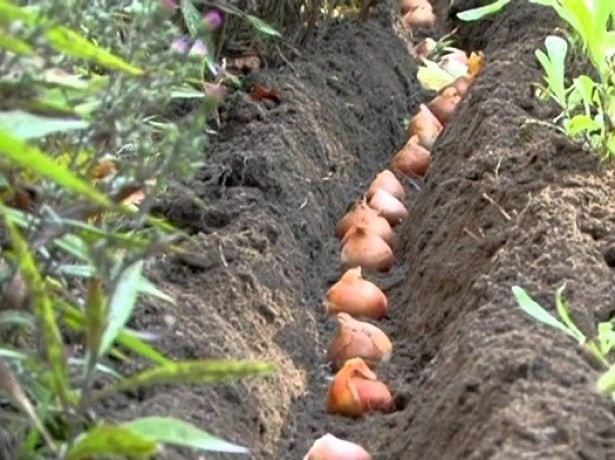

Vegetation of tulips occurs in two ways: the formation of a daughter bulb near the mother and by seeds. The latter method is little known among amateur gardeners and is used most often by breeders on an industrial scale. Before planting, the bulbs are carefully inspected for damage and disease. Partially affected can be cut off and treated with a manganese solution. Planting takes place in the fall - in September or October. It all depends on the temperature regime, ideally it ranges from 3 to 7 degrees Celsius. The depth of the planting hole is from 6 to 14 cm in depth, depending on the size of the planting material. Next, the hole is mulched, after the onset of frost, it is covered, the shelter must be removed in early spring.
Leaving begins during the snow period. The first feeding is carried out. Nitrogen fertilizer penetrates to the bulbs along with the melted snow. Phosphorus feeding is carried out during the period of bud appearance. The fertilizer is applied in a complex with microelements. Be sure to loosen. Tulips need to be watered regularly, weeded and loosened. When the leaves turn yellow and scales have formed on the bulb, you can dig them out. Store in a form cleared of earth, in paper.
Tulips and daffodils (20 photos)
It is extremely important, in the absence of perennials in flower beds, to correctly plan the space, which should not be empty throughout the summer period. As a rule, flower growers recommend placing ground cover flowers in flower beds after tulips. The most popular planting of such plants as aubrieta, subulate phlox and arabis, the foliage of which is not able to shade tulips. This promotes the complete and high-quality ripening of the bulbs.

